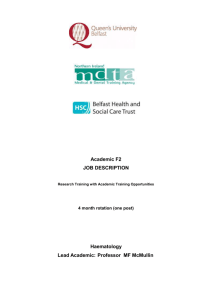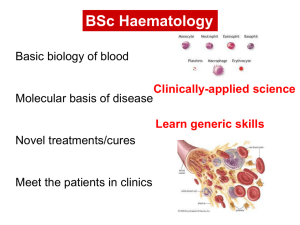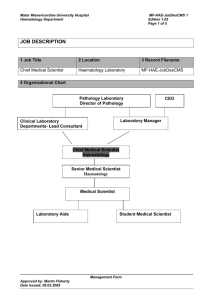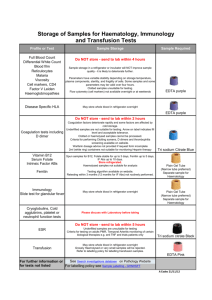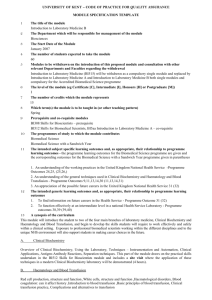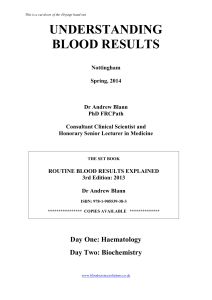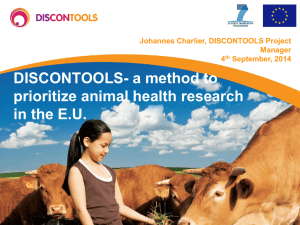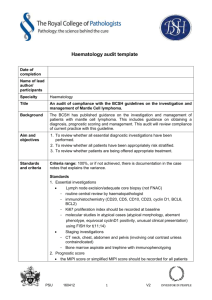Appendix 1
advertisement
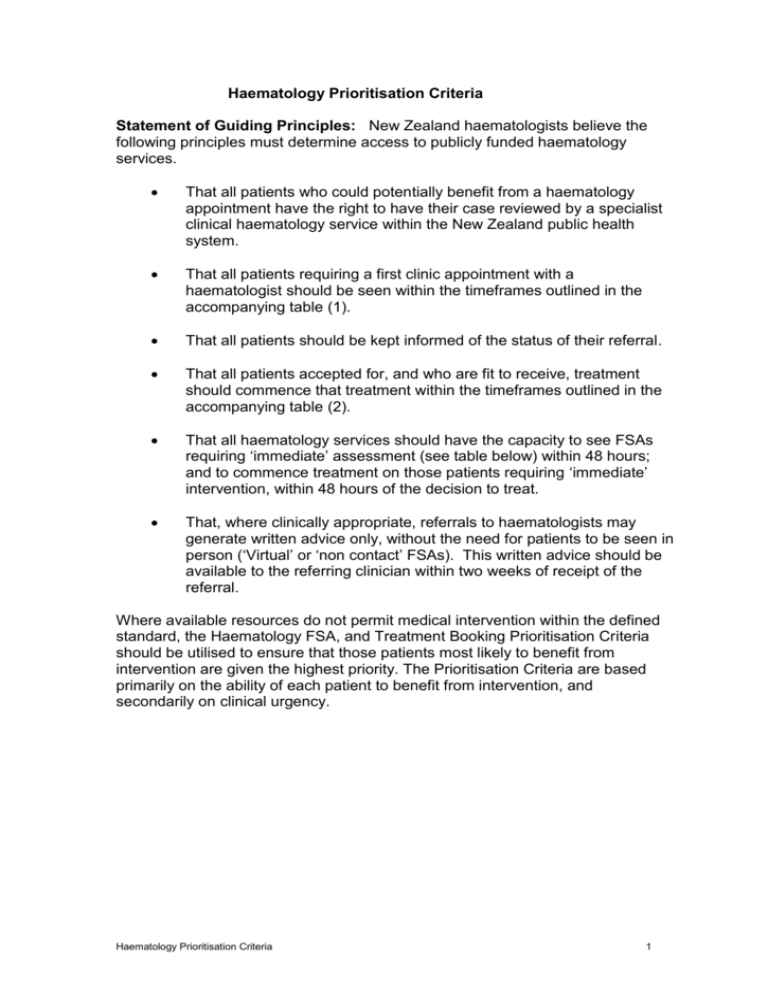
Haematology Prioritisation Criteria Statement of Guiding Principles: New Zealand haematologists believe the following principles must determine access to publicly funded haematology services. That all patients who could potentially benefit from a haematology appointment have the right to have their case reviewed by a specialist clinical haematology service within the New Zealand public health system. That all patients requiring a first clinic appointment with a haematologist should be seen within the timeframes outlined in the accompanying table (1). That all patients should be kept informed of the status of their referral. That all patients accepted for, and who are fit to receive, treatment should commence that treatment within the timeframes outlined in the accompanying table (2). That all haematology services should have the capacity to see FSAs requiring ‘immediate’ assessment (see table below) within 48 hours; and to commence treatment on those patients requiring ‘immediate’ intervention, within 48 hours of the decision to treat. That, where clinically appropriate, referrals to haematologists may generate written advice only, without the need for patients to be seen in person (‘Virtual’ or ‘non contact’ FSAs). This written advice should be available to the referring clinician within two weeks of receipt of the referral. Where available resources do not permit medical intervention within the defined standard, the Haematology FSA, and Treatment Booking Prioritisation Criteria should be utilised to ensure that those patients most likely to benefit from intervention are given the highest priority. The Prioritisation Criteria are based primarily on the ability of each patient to benefit from intervention, and secondarily on clinical urgency. Haematology Prioritisation Criteria 1 Table 1 Haematology FSA Prioritisation Criteria Category Criteria 1 Immediate - see within 48 hours (usually require admission to haematology inpatient unit) Patients with severe cytopenias, coagulopathies, or responsive cancers who are severely symptomatic and, if not treated quickly, would suffer serious morbidity or threat to life 2 Urgent - see within one week All potentially curable cancers, where delay may jeopardise patient outcome Responsive cancers, with significant symptoms or documented rapid progression requiring urgent intervention Known responsive cancers with defined prolongation of life/high chance of palliation Disorders with a high risk of thrombosis, bleeding or other organ damage 3 Semi-urgent - see within four weeks 4 Routine - see within four months 5 Advice only - letter to referrer, no appointment need be offered for some cases Cancers with known indolent behaviour Mild blood count or other laboratory abnormalities for investigation Straightforward clinical issue, not requiring therapy Very low or unlikely benefit from investigation or treatment Haematology Prioritisation Criteria Examples (Note that these examples are a guide only and the triaging Haematologist may place referrals with these diseases in different categories because of the specific clinical circumstances pertaining to an individual referral) Acute leukaemia Burkitt lymphoma Superior vena caval obstruction in diagnosed, chemotherapy responsive, cancers eg, NHL Severe aplastic anaemia Severe autoimmune cytopenias Thrombotic thrombocytopenic purpura Severe haemophilia, with significant bleeding Aggressive non-Hodgkin lymphoma Hodgkin lymphoma Symptomatic plasma cell myeloma Advanced chronic lymphoproliferative disorders (eg, stage C chronic lymphocytic leukaemia) Low grade lymphoma/leukaemia Asymptomatic plasma cell myeloma Myeloproliferative disorders Moderate autoimmune cytopenias Moderate bleeding / thrombotic disorders Severe iron overload Early myelodysplastic syndromes Early myeloproliferative disorders Mild autoimmune cytopenias Mild bleeding / thrombotic disorders Mild iron overload Monoclonal gammopthy of uncertain significance Monoclonal B-cell lymphocytosis Stage A chronic lymphocytic leukaemia Minor blood test abnormalities 2 Table 2 Haematology Treatment Booking Priority (Maximum wait times from the decision to treat) Category A Immediate - within 48 hours Criteria Responsive cancers with rapidly progressive malignancy or complication of malignancy, where if not treated will suffer serious morbidity or threat to life Severe cytopenias or coagulopathy Examples B Semi-urgent - within two weeks* C Routine - within four weeks All potentially curative cancers Responsive cancer with evidence of rapid progression, which if not treated promptly may give rise to major complications or worsening of prognosis All other cases requiring active and palliative systemic treatment Acute leukaemia Severe aplastic anaemia Thrombotic thrombocytopenic purpura Aggressive non-Hodgkin lymphomas with severe symptoms of rapid progression Burkitt lymphoma Superior vena caval obstruction in chemotherapy-responsive cancers Severe haemophilia or other bleeding disorder with active haemorrhage Aggressive non-Hodgkin lymphoma Hodgkin’s lymphoma Symptomatic plasma cell myeloma Stage C chronic lymphocytic leukaemia * Within Category B there may be certain patients who, while not requiring Immediate intervention, need to commence treatment before two weeks. Such cases, and the necessary time to start of treatment should be identified by the prioritising haematologist. Haematology Prioritisation Criteria 3

